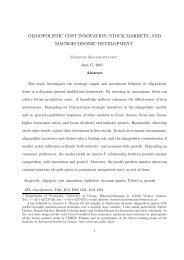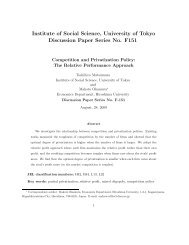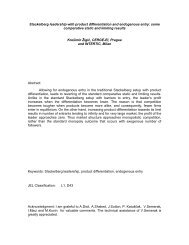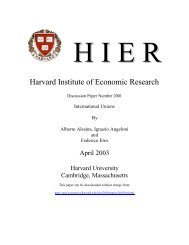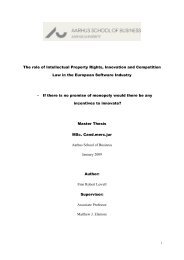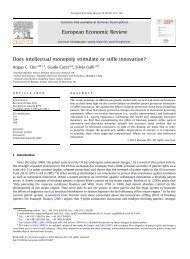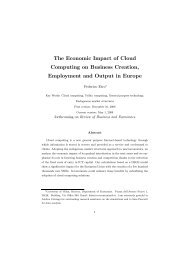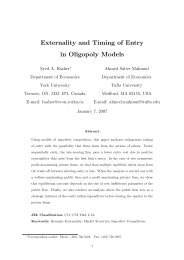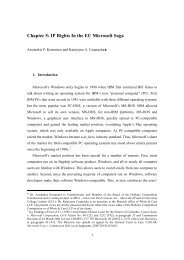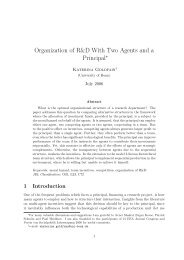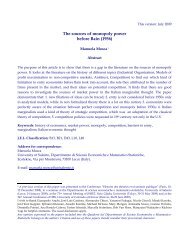The EU Approach to Abuse of Dominance - Intertic
The EU Approach to Abuse of Dominance - Intertic
The EU Approach to Abuse of Dominance - Intertic
Create successful ePaper yourself
Turn your PDF publications into a flip-book with our unique Google optimized e-Paper software.
“[r]ivals may be disadvantaged where the dominant company is able <strong>to</strong> … reduce demand for the rivals’<br />
products” (# 58) which is really what any aggressive or pro-competitive strategy would do. Putting<br />
<strong>to</strong>gether the two sentences, we are <strong>to</strong>ld that it would be sufficient <strong>to</strong> establish foreclosure that the<br />
strategy <strong>of</strong> the dominant firm reduces demand for the rivals’ product: but this amounts <strong>to</strong> banish any<br />
pro-competitive strategy by market leaders. Moreover, the above statement could arguably support the<br />
conclusion that a dominant company in a market characterized by network effects could be guilty <strong>of</strong><br />
abuse if it is able <strong>to</strong> attract new cus<strong>to</strong>mers on the basis <strong>of</strong> a new, superior technology. This view is<br />
contrary <strong>to</strong> the basic principle that dominant companies should be permitted (and indeed encouraged)<br />
<strong>to</strong> compete aggressively on the merits. Allowing a finding <strong>of</strong> abuse merely where competi<strong>to</strong>rs are<br />
“disadvantaged” would penalise dominant firms for engaging in a wide range <strong>of</strong> conduct that is<br />
ultimately pro-competitive. In our view, this aspect <strong>of</strong> the analytic framework should be revised <strong>to</strong><br />
clarify that conduct by a dominant firm would be deemed <strong>to</strong> be an abuse only if its net effect is <strong>to</strong> harm<br />
consumer welfare. 11<br />
<strong>The</strong> Discussion Paper states that the Commission may at times prohibit the use <strong>of</strong> price<br />
discounts where doing so will “protect competi<strong>to</strong>rs that are not (yet) as efficient as the dominant<br />
company” (# 67). In our view, there is no economic justification for barring dominant firms from<br />
decreasing prices simply in order <strong>to</strong> protect less efficient rivals (particularly since such a prohibition will<br />
mean that these rivals will face even less competitive pressure <strong>to</strong> become more efficient). This<br />
condition also places dominant firms in the untenable position <strong>of</strong> having <strong>to</strong> guess what level <strong>of</strong> rival<br />
inefficiency will be used <strong>to</strong> judge whether the dominant firm’s own efficiency-enhancing conduct is<br />
lawful. <strong>The</strong> Discussion Paper also states, in its discussion <strong>of</strong> the meeting competition defense, that a<br />
dominant firm has an obligation <strong>to</strong> weigh “the interests <strong>of</strong> its competi<strong>to</strong>rs <strong>to</strong> enter or expand” in<strong>to</strong> the<br />
market when deciding upon alternative courses <strong>of</strong> action, and that dominant firms can only benefit<br />
from this defence if they prove there was no less anticompetitive alternative (# 82-83). In the real<br />
world, the best businesses are focused on advancing the interests <strong>of</strong> their cus<strong>to</strong>mers, not their<br />
competi<strong>to</strong>rs (which, <strong>of</strong> course, is one sign <strong>of</strong> a competitive market). Thus, most dominant firms will be<br />
ill-equipped <strong>to</strong> evaluate which <strong>of</strong> various possible options will least disadvantage their competi<strong>to</strong>rs. We<br />
Moreover, when entry <strong>of</strong> competi<strong>to</strong>rs is endogenously taken in<strong>to</strong> account (which should be the relevant case), an<br />
aggressive behaviour <strong>of</strong> the leader does not affect each single competi<strong>to</strong>r but can reduce entry, with net effects<br />
for consumer welfare and allocation <strong>of</strong> resources which are always positive (Etro, 2006). Hence, an aggressive<br />
behaviour <strong>of</strong> the market leader inducing less aggressive competition <strong>of</strong> the competi<strong>to</strong>rs is not sufficient <strong>to</strong> create<br />
any harm <strong>to</strong> consumers or <strong>to</strong> deteriorate the allocation <strong>of</strong> resources.<br />
11 See, e.g., Commissioner Neelie Kroes, Preliminary Thoughts on Policy Review <strong>of</strong> Article 82, at 3 (23 Sept. 2005)<br />
(stating that, in the analysis <strong>of</strong> exclusionary conduct under Article 82, “ultimately the aim is <strong>to</strong> avoid consumers<br />
harm”).<br />
7



